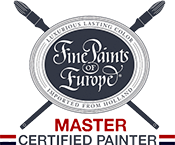Understanding Light Reflective Value (LRV) in Paint
September 27, 2022

Light affects paint color in significant ways. If you’ve ever decided on a paint color only to have it show up differently on the wall in your home, this comes down to its light reflective value (LRV).
It’s always essential to consider paint light reflective value before painting specific rooms in your home. For instance, basements, hallways and powder rooms will usually have less natural light than other parts of the house. Bedrooms, living rooms and kitchens will likely be brighter, affecting the color of paint you ultimately choose for these rooms.
Choosing the right LRV in paint will help you coordinate room colors, create a mood and design spaces that match your stylistic preferences. Learn more about LRV and how to choose the best paint colors for your home.
What Is LRV in Paint?
Science tells us that we’re not seeing the paint color on the walls but rather the color of light reflected from it. Therefore, a color’s light reflective value — also known as its light reflectance value — measures the amount of visible and usable light that reflects from or absorbs into a painted surface.
On a scale of 0-100 — with 0 being black and 100 being white — LRV quantifies the amount of light a paint color will reflect or absorb on your walls. Absolute black will absorb all light and heat, while pure white will reflect all light.
You may have noticed an LRV paint color chart on the back of a fan deck or color strips at your favorite paint store. The meanings behind these values are as follows:
- 0-40: A low LRV is in the 0-40 range, encompassing the darker colors that absorb more light than what’s reflected back.
- 40-60: Paint colors in the 40-60 range are considered medium LRV. They will reflect an average amount of light.
- 60-100: Colors in the 60-100 range are considered a high LRV. These paint colors will reflect a lot of light.
Essentially, the higher the LRV paint colors indicated on the strips, the lighter the color is, while a lower LRV is a darker color. These numbers can significantly affect how your room looks and feels, depending on how much natural or artificial light it gets.
Everyone from architects and engineers to interior designers and color consultants uses LRV to predict how light or dark a color will appear in a room. These values can even help lighting designers calculate the number and type of light fixtures needed to light interior spaces. When shopping for a new color for your walls, consider these values before making a decision.
Why Does Understanding the Light Reflective Value of Paint Matter?
LRV can significantly impact the appearance of paint in different lighting conditions. For this reason and others, it’s vital to consider LRV before purchasing a color for your home.
1. Make the Best Purchase
Understanding light reflectance value can help you make the best purchase of paint for your home. When you make the right LRV paint color choice, you’ll feel better about the time that goes into painting your home. You’ll always ensure your rooms look spectacular, with high-quality paint that looks amazing no matter the amount of light in your spaces.
So, before choosing a paint, ensure it will look great depending on the amount of light in the room you’re painting. The correct LRV will show off the beautiful undertones in your paint and enhance your other interior design choices. It will spare you time and money since you won’t need to go back to purchase more paint or have professionals redo your space.
When you hire professionals from Shoreline Painting to get the job done right, you’ll save time and energy on the painting process. We can also help you find the right LRV to complement your interior spaces through color consulting.
2. Coordinate Rooms
Paint light reflective value can help you coordinate wall colors throughout your home. Due to LRV, one color may look fantastic in your dining room but be a little too bright in the family room. Coordinating colors can get tricky for this reason, though when you understand LRV, you can choose the colors that will match or complement one another, depending on the lighting in each room of your home.
If one wall receives more light than others, you could go a shade lighter or darker to help it fit more appropriately with the other walls in the room. Hues might also vary throughout the day as light changes from morning to night, so you could test out a few colors and see how they change depending on the type of day. These are all essential factors to consider to help you choose the right paint for your home.
3. Craft a Mood
Paying attention to a color’s LRV can help determine how it will contribute to a room’s overall aesthetic. A color with a higher LRV might create a light and airy vibe, while a color with a lower LRV will align better with a dark, moody feel. It’s important to remember that choosing a higher LRV paint color doesn’t necessarily mean it will appear lighter if you don’t have enough natural or artificial light in a room.
Consider light reflectance value to craft the right mood. Colors can help dictate the way we feel. Perhaps you’re hoping to feel energized and motivated in your home office or gym and relaxed in the living room or bedroom. High LRV colors combined with a lot of natural light can introduce that energy, while low LRV colors combined with less light can provide a more relaxed vibe.
4. Be Energy-Efficient
Choosing the right LRV in paint can help you stay energy-efficient. Since high LRV paint colors are more reflective, you likely won’t require as much lighting or air conditioning as you would with lower LRV paints, which soak up light and warm more easily.
The Environmental Protection Agency (EPA) reports that electric lighting accounts for 25% of the electricity used in the U.S. Overall, lighter-colored walls with a higher LRV will reflect heat and are better for maximizing energy efficiency by preventing you from turning lights on earlier in the day. This means you’ll save on your monthly electric bill and ensure optimal comfort by understanding LRV.
How to Choose a Paint Color Based on LRV
Now that you understand the importance of paint light reflective value, see how to choose a color for interior rooms and exterior spaces.
What Is the Best LRV for Interior Paint?
Remember that the higher the LRV number, the lighter the color, and the lower the LRV number, the darker the color. This difference can significantly affect your room’s overall feel and comfort levels depending on how much natural or artificial light your room gets.
Learn how to decide on the best paint color for LED lighting, other artificial lights or natural light with these suggestions:
1. Natural Light
It’s important to consider natural light before deciding on paint. A general rule is that if your room is north-facing, it will let in less light. As a result, darker paints will appear darker, and light paints will appear dimmer. On the other hand, a south-facing window will bring more intense light, so dark colors will look brighter, and light colors can make a room look washed out.
For this reason, a medium LRV makes an excellent choice in paint colors for rooms with lots of natural light, and a higher LRV is ideal as a light-reflecting paint for dark rooms.
2. Artificial Light
Standard incandescent light will provide warm, natural lighting making bright colors appear more intense and cooler paints a little duller. Bright colors with a higher LRV include reds, oranges and yellows. Cooler paints with a lower LRV can consist of greens, blues and grays. If you have adequate artificial lighting in your room, you can opt for a lower LRV, and the color will still show through.
Warm incandescent bulbs like the vintage “Edison” bulks create a warm, sometimes amber hue to a room. These vintage lighting options may not cast much lighting, making a high LRV paint a wise choice. Fluorescent and LED lights provide a blue, cool light that mutes warm colors and pairs well with medium to high LRV paints often used in workplaces or kitchens.
3. Light Positioning
It’s also important to keep in mind the many effects you can create just by how you position your lighting. Chandeliers and overhead fixtures offer a lot of light to your room by distributing it evenly throughout your space, making low LRV suitable if you want a moody feel.
Table and floor lamps are excellent options if you don’t get enough natural light, but you should opt for a higher LRV paint if these are your only light sources.
String lights and candles are great for adding a warm and cozy vibe to a room. They can warm up bright or high LRV paint colors.
4. Paint Finish
Lastly, a significant part of choosing paint colors is deciding the type of finish that will look best in your room. Flat, gloss and semi-gloss are all types of finishes that can affect how the color changes in certain lights. Generally, the glossier the finish, the more light it will reflect, while flat finishes will have less bounce. High gloss suits any range of LRV in paint, whether you want to add drama or light.
By considering your interior lighting, positioning and paint finish, you can find an LRV that complements the space and gives you the ideal atmosphere.
To create a light and airy room in a space with enough lighting, choose colors with an LRV above 50. These shades will reflect more light than they absorb and create a more “daytime look” that feels more expansive and roomy. For a darker, more sophisticated look, choose colors with an LRV below 50. These shades will absorb more light than they reflect and create an intimate feel, which is why many opt for low LRV colors in their dining spaces.
What Is the Best LRV for Exterior Paint?
There are many ways you can go about choosing an exterior paint color. LRV can significantly impact the look and feel of your home:
- Exterior walls: Whites are often ideal if you’re hoping for better energy efficiency and cooler indoor temperatures in the warmer months. These shades have a high light reflectance value. If your home gets direct natural light, white paint will make it appear lighter and more reflective of other colors surrounding it. In cooler climates, consider darker colors to keep a warmer home — they’ll absorb more light and transfer it as heat into your indoor spaces. Light-colored exterior walls with a high LRV can maintain a cooler home in warm climates.
- Roof: You might also consider a light-colored roof for the same reason. Without good insulation, direct light can transfer heat into your home through the ceiling. As a result, your cooling systems will have to work harder to maintain a stable temperature, making paint light reflective value essential to consider before painting your home’s exterior.
- Outdoor lighting: A home with darker paint and a low LRV may need more exterior lighting under a porch or entryway. Since dark paint won’t reflect light, using more types of lighting can enhance your space and show off paint colors even more.
- Textures: Paint appears differently on different textures. A lot of texture on your exterior walls will create shadows and change how you perceive the colors, so keep this in mind before deciding on exterior paint. High LRV colors will show off texture, while darker colors with low LRV mask texture.
- Glare: Keep in mind that a paint color with an LRV higher than 85 will likely be too bright, which might cause you to squint when looking at a house on a hot day. If you’re opting for white, try to find a color with an LRV between 70 and 85 to avoid this scenario.
Schedule a Consultation With Shoreline Painting & Drywall
When it comes time to freshen up your interior or exterior spaces with new paint, consider Shoreline Painting & Drywall. We have over 35 years of experience helping homeowners achieve their dream home. Our expert painters are fully licensed, bonded and insured and have completed interior and exterior painting jobs throughout New York and Connecticut. We approach every interior and exterior painting project as if we are painting our own homes.
By considering LRV and essential features of your home, we can help you craft your ideal aesthetic and coordinate your home’s walls and style for the best look. Regarding exterior paint, we also prioritize durability, energy efficiency and high-quality paints and colors that will make your home stand out and increase its curb appeal.
Shoreline Painting & Drywall is a Fine Paints of Europe Certified Master Painter with decades of experience that will show in your home’s transformation. Contact us today to schedule a consultation.
Recent Posts & Guides












